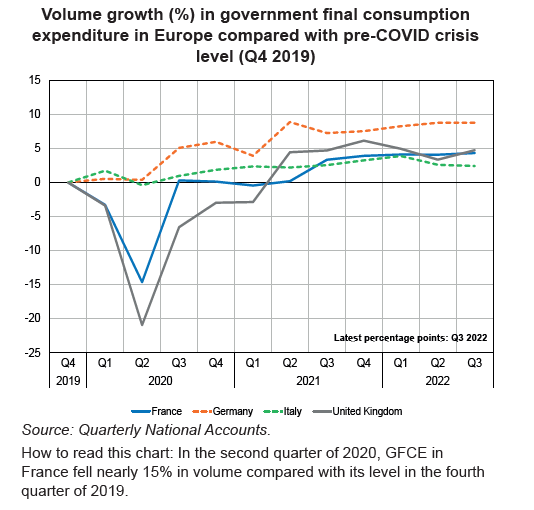Measurement of Government Consumption and Its Impacts on Output in 2020 and 2021
Public consumption encompasses the services provided to households by government departments. In the first half of 2020, it fell significantly in France and the United Kingdom while remaining stable or rising in Germany, Italy and Spain. These divergences are essentially due to different manners of measuring public service activity during the lockdowns. They argue in favour of prudent interpretation of the differences in growth between European countries in 2020 and 2021.
Government final consumption expenditure (GFCE) is a component of final demand in the national accounts. It covers services provided to households by public administrations, including both the direct production of public services by central government, local government and social security bodies (such as education and defence) and expenditure incurred by government bodies for services provided by the private sector (such as healthcare reimbursements).
GFCE stood at 23% of GDP in France in 2019, at a level similar to the other leading European countries.Growth in GFCE is therefore an important component of GDP growth, but it is harder to measure than other components mostly because of the absence of market-based prices.
The French National Institute of Statistics and Economic Studies (INSEE) and its UK counterpart the Office for National Statistics (ONS) reported a sharp decline in the output of public services during the first lockdown in the spring of 2020. The national statistics institutes in the other leading European countries (Germany, Italy and Spain), however, considered that the production of public services had not dropped.
INSEE and the ONS used additional indicators, such as the loss of teaching activity, whereas the other institutes kept their usual methodology.
The national statistics institutes estimated that the drop in GFCE in 2020 depressed GDP growth by -0.9 pp in France and -1.4 pp in the UK, whereas it contributed 0.8 pp to GDP growth in Germany and 0.7 pp in Spain.
The fact that these differentials reflect at least in part the different methodological choices made to measure output in 2020 suggests that differences in GDP growth between European countries in 2020 and 2021 should be interpreted with caution. These choices cease to affect GDP growth from 2022 onwards.
